Keto Diet for Beginners: Guide to Starting Ketosis
Curious about the buzz around the keto diet? In the next few minutes you will learn what ketosis means, why it can accelerate fat loss, and which first steps keep you safe. I share plain-English science, expert insights from Johns Hopkins University and the Mayo Clinic, and practical tips you can use tonight. By the end you will know if a ketogenic approach fits your goals and how to launch your personal keto diet plan with confidence.
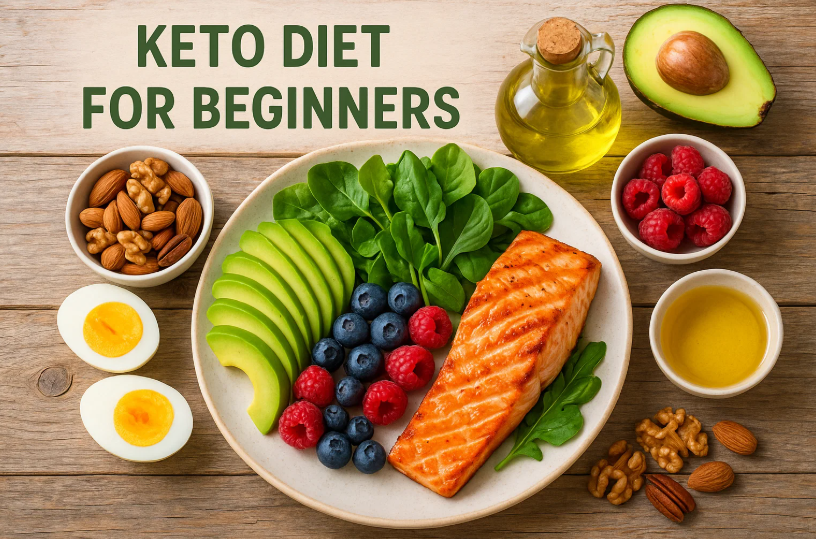
What Is the Ketogenic Diet?
The ketogenic, or “keto,” diet is a very-low-carbohydrate, high-fat, moderate-protein eating pattern. When daily carbs drop below roughly 50 grams, your body switches from burning glucose to burning fat and producing ketone bodies for energy. That metabolic shift is called ketosis.
Understanding Ketosis: How Your Body Burns Fat for Fuel
Think of your metabolism as a hybrid car. Glucose is the regular gas; fat is the electric mode. On a keto diet, you empty the gas tank, so the engine flips to battery power. In human terms, your liver turns stored and dietary fat into ketones, which cross the blood–brain barrier and feed your cells.
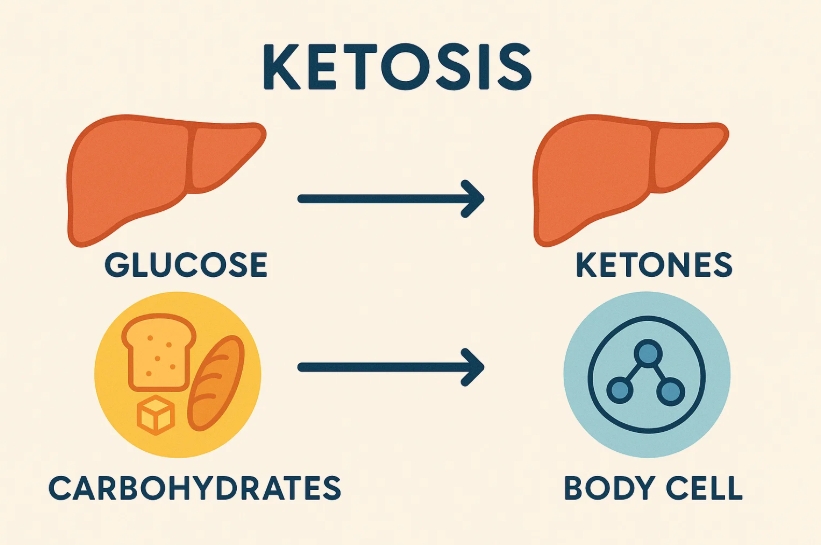
Explanation of terms
- Ketone bodies – β-hydroxybutyrate (BHB), acetoacetate, and acetone produced in the liver.
- Net carbs – total carbs minus fiber and sugar alcohols; this number guides keto meal tracking.
According to experts from Harvard Medical School, ketones suppress appetite-stimulating ghrelin, which helps many beginners eat less without counting every calorie.
The Science Behind Keto: A Brief History and Mechanisms
Clinicians at Johns Hopkins first used ketogenic therapy in 1921 to reduce epileptic seizures in children. Interest faded with modern antiepileptic drugs, then exploded again in the 1990s after dramatic TV coverage of a patient’s recovery. Today, peer-reviewed studies report that a well-formulated keto diet for weight loss lowers insulin levels, improves triglycerides, and can outpace a traditional low-fat diet for short-term fat reduction.
What experts say
“Ketogenic nutrition is a powerful medical tool, but it is not magic. Personalization and clinical monitoring are essential,” notes Dr. Eric Kossoff, neurologist at Johns Hopkins Hospital.
Important Precautions and Medical Consultation Before Starting Keto
A ketogenic approach changes electrolytes, hormones, and medications. Reading this section carefully protects your health and sets realistic expectations.
Who Should (and Shouldn’t) Consider Keto?
Before adjusting your menu, review the groups below.
- Generally suitable: Adults with obesity, insulin resistance, or type 2 diabetes under supervision; athletes needing body-composition cuts; motivated beginners looking for a structured keto diet menu.
- Use extreme caution: Pregnant or breastfeeding women, adolescents, older adults with osteoporosis risk, individuals with a history of eating disorders.
- Often contraindicated: People with type 1 diabetes, pancreatitis, severe liver disease, or rare metabolic disorders such as CPT-I deficiency.
A study in the 2025 Cleveland Clinic report emphasizes that screening kidney function and lipid panels first can prevent complications.
After deciding, remember: keto is optional. Mediterranean, DASH, or even a balanced low-carb diet may match your lifestyle better.
The Importance of Talking to Your Doctor or a Registered Dietitian
Schedule a pre-keto visit. Your clinician will:
- Review current medications that might need dose reductions as insulin drops.
- Order baseline labs for glucose, HbA1c, lipids, and electrolytes.
- Recommend a personalized keto diet calculator target for fat, protein, and carbs.
Follow-up every 4–6 weeks catches early nutrient gaps. A registered dietitian can translate lab numbers into a sustainable grocery list and monitor symptoms such as the keto flu. According to experts, documented in a 2024 Mayo Clinic white paper, guided programs double six-month adherence compared with do-it-yourself plans.
Remember, if severe nausea, vomiting, or confusion appear, seek medical help immediately—those signs can signal ketoacidosis in vulnerable individuals.
Starting with clear definitions, historical context, and professional safeguards positions you for success on a beginner-friendly keto diet. Next up, we will calculate macros, stock your kitchen, and navigate early-week hurdles so you can enter ketosis smoothly.
Getting Started on Keto: Your First Steps
Beginning a keto diet feels overwhelming until you break the launch into small, logical actions. In this section I cover the math, the grocery cart, and the early-week road bumps so you enter ketosis smoothly and safely—and see how a diet for long-term weight loss can slot into busy life without confusion about what’s allowed.
Calculating Your Keto Macros: Carbs, Protein, and Fat
Every eating plan revolves around three macronutrients—carbohydrates, protein, and fat—commonly shortened to macros. On a ketogenic pattern carbs drop so low that fat becomes the body’s main fuel.
Most beginners target roughly 70 % fat, 25 % protein, and 5 % net carbs. Net carbs equal total carbs minus fiber and sugar alcohols. That formula keeps daily carbs under 50 g for most adults, yet leaves protein high enough to protect muscle. A 2024 National Institutes of Health review notes that personal carb ceilings vary with age, activity, and insulin sensitivity; therefore, use an online calculator only as a starting point and verify numbers with a registered dietitian. This diet for obesity management may also require tighter medical oversight.
| Goal | Fat % | Protein % | Net Carbs % |
| Weight-loss focus | 70 | 25 | 5 |
| Weight maintenance | 65 | 30 | 5 |
| Athletes (cutting) | 60 | 35 | 5 |
Tracking macros once or twice a year helps you recalibrate after body-composition changes. Between those reviews, a simple plate-comparison method (“thumb of butter, palm of steak”) keeps life sane.
Setting Up Your Keto Kitchen: What to Stock
A ready pantry beats willpower. Start with a focused grocery sweep, then remove high-carb temptations the same day so the path of least resistance is keto-friendly.

Essential proteins
- Grass-fed beef, chicken thighs, pork shoulder
- Salmon, sardines, shrimp
- Pasture-raised eggs
Healthy fats
- Avocado oil, extra-virgin olive oil, coconut oil
- Avocados, olives
- Almonds, macadamias, pumpkin seeds
Low-carb vegetables & fruit on keto
- Spinach, kale, arugula
- Cauliflower, broccoli, zucchini
- Mushrooms, bell peppers
- Handfuls of raspberries or blackberries as the only approved fruit on keto roster
Full-fat dairy
- Cheddar, Brie, cream cheese
- Heavy cream, unsweetened Greek yogurt
Quick snacks
- Beef jerky with no sugar
- String cheese, hard-boiled eggs
- Nut-butter pouches
- Pre-portioned keto jalapeño popper casserole squares for spicy convenience
Notice that each category supplies both macronutrients and micronutrients. By organizing shelves this way you build balanced lunches in minutes and reduce last-second take-out orders.
What to Expect in the First Few Days/Weeks: The Keto Flu and How to Manage It
When glucose stores empty, kidneys flush water and electrolytes; that shift explains the so-called keto flu—temporary fatigue, headaches, and brain fog.
Common symptoms during days 2–5
- Thirst and dry mouth
- Light dizziness
- Muscle cramps at night
- Irritability or low mood
Simple fixes ease the transition. Drink at least three quarts of water daily, add ½ teaspoon mineral salt to one glass, and include potassium-rich foods such as avocado or spinach. Magnesium-citrate at bedtime calms leg cramps and supports deep sleep. Within a week most newcomers report rising energy as ketone levels climb—evidence that the diet actually works when electrolytes stay balanced.
How to Reach Ketosis & Signs You Are In Ketosis
With carbs below 50 g and protein moderate, liver glycogen depletes in roughly 48–96 hours. Exercise and intermittent fasting shorten that window by tapping stored glucose faster.
Indicators you’ve crossed into ketosis
- Metallic or fruity breath odor
- Noticeably reduced appetite
- Stable afternoon energy without coffee
- Slight rise in mental clarity
To confirm the switch, measure ketones via urine strips (cheap), breath meters (mid-priced), or blood BHB monitors (gold standard). Consistency beats perfect precision for most lifestyle goals; this holds for a cyclical ketogenic approach as well.
Tracking Your Progress: Monitoring Ketosis and Other Metrics
Macro logs matter, yet they’re only one feedback loop. Broader monitoring shows whether chosen numbers translate into real-world results.
Key metrics beyond carb counts
- Body weight and waist circumference every Monday
- Progress photos once a month under identical lighting
- Daily energy score from 1-10 in your journal
- Sleep duration from a wearable device
- Strength numbers on primary lifts
A 2025 Cleveland Clinic report found combining objective data with subjective cues improves adherence by 40 %. Even if weight stalls temporarily, rising energy or shrinking jeans confirm you remain on track for effective for weight loss outcomes.
Typical mistakes include skipping electrolytes, under-eating protein, or chasing ultra-low calories too soon. By computing macros carefully, stocking the right foods, and logging personal signals, you avoid those pitfalls and turn your first month of keto into a confident habit—proof that a smart keto diet may launch lasting change.
The Keto Food Guide: What to Eat and What to Avoid
A successful keto diet food list keeps you in ketosis without boredom or nutrient gaps. This guide shows what to eat on keto diet days, what to limit, and why it matters for long-term weight management. By the end you will build plates that match every keto diet plan for beginners and seasoned low-carb veterans alike.
Even if you already know what is a keto diet, translating theory into grocery choices can feel tricky. Use the five food groups below as a daily checklist. When each group appears on your plate, macros stay on target and you naturally follow the key keto diet rules—less than 50 g net carbs, moderate protein, and plenty of healthy fat.
Keto-Friendly Food Groups: Building Your Meals
Your core meal template looks like this: pick a moderate protein, surround it with low-carb vegetables, add a generous fat source, and finish with optional full-fat dairy or a handful of berries. This structure supports Mediterranean-style variety while honoring ketogenic macros.
Main keto-friendly groups
- Proteins: meat, fish, eggs
- Healthy fats: oils, avocado, nuts, seeds
- Low-carb vegetables: leafy greens, crucifers
- Dairy and alternatives: cheese, heavy cream, coconut-based “milks”
- Fruits in moderation: mainly berries
Start each shopping trip by ticking off those categories; the habit keeps decision fatigue low and compliance high.
Proteins (Meat, Fish, Eggs)
Protein stays moderate on a ketogenic diet—roughly 1.2–1.6 g per kilogram of goal body weight. That range preserves lean tissue without kicking you out of ketosis through excess gluconeogenesis.
| Protein source | Serving | Protein g | Fat g | Net Carbs g | Notes |
| Ribeye steak | 4 oz | 23 | 20 | 0 | Rich in zinc and B-12 |
| Chicken thigh (skin-on) | 4 oz | 21 | 10 | 0 | Budget-friendly staple |
| Wild salmon | 4 oz | 24 | 13 | 0 | Adds omega-3 DHA |
| Eggs | 2 large | 12 | 10 | 0.6 | Choline for brain health |
| Greek yogurt, plain (5 %) | ½ cup | 10 | 6 | 3 | Choose unsweetened |
Choose fattier cuts to hit macro ratios with less added oil. Rotate animal and seafood options to mimic the nutrient diversity of a Mediterranean keto diet.
Eating too little protein slows recovery; too much may raise glucose. Find a middle ground by filling one-quarter of your plate with the protein row above and tracking results weekly.
Healthy Fats (Oils, Avocado, Nuts, Seeds)
Fat is the primary energy on a high-fat diet. Focus on quality over pure quantity; diverse unsaturated fats support heart health while keeping satiety high.
| Fat source | Predominant type | Benefit |
| Extra-virgin olive oil | Monounsaturated | May improve HDL per American Heart Association |
| Avocado | Monounsaturated | Supplies potassium, counters water weight loss |
| Coconut oil | Saturated (MCTs) | Quick ketone boost; useful before workouts |
| Macadamia nuts | Monounsaturated + low omega-6 | Travel-friendly snack |
| Chia seeds | Polyunsaturated ALA | Adds fiber and plant omega-3 |
Drizzle one to two tablespoons of oil over vegetables, mash half an avocado into tuna salad, or sprinkle nuts on keto yogurt. These simple moves meet fat targets without relying on processed “keto diet pills” or powders.
Remember that calories still count for fat loss. If you stall, reduce nuts first—they pack energy quickly.
Low-Carb Vegetables: Your Essential Fiber and Nutrients
Vegetables on keto provide fiber that eases digestion and phytonutrients that support immunity. Prioritize varieties that deliver maximum volume for minimal carbs.
| Vegetable (raw) | Serving (1 cup) | Net Carbs g | Fiber g | Notable micronutrient |
| Spinach | 30 g | 1 | 0.7 | Folate |
| Zucchini | 124 g | 3 | 1 | Potassium |
| Cauliflower | 107 g | 3 | 2 | Vitamin C |
| Broccoli | 91 g | 4 | 2.4 | Sulforaphane |
| Bell pepper | 92 g | 4 | 2 | Vitamin A |
Aim for two fist-size servings of greens at lunch and dinner. Sauté them in olive oil to enhance absorption of fat-soluble vitamins—an evidence-based tip noted by Harvard T.H. Chan School of Public Health.
A colorful mix prevents the constipation sometimes reported in the first weeks of starting a ketogenic diet.
Dairy and Alternatives
Full-fat dairy can enrich flavor and supply calcium, yet lactose increases total carbs. Gauge tolerance and track labels closely.
Enjoy freely
- Hard cheeses: Cheddar, Gouda, Parmesan
- Soft cheeses: Brie, Camembert
- Heavy cream or half-and-half in keto coffee
Use with caution (watch net carbs)
- Plain Greek yogurt (5 % milkfat)—keep to ½ cup
- Cottage cheese—limit to ½ cup
Generally avoid
- Sweetened yogurt, flavored milk, condensed milk
- Regular cow’s milk—12 g sugar per cup
Coconut milk and almond milk (unsweetened) work well in keto diet recipes such as mug cake keto or keto jalapeño popper casserole, keeping carbs low while adding creaminess.
Fruits on a Keto Diet: Enjoying Berries in Moderation
Most fruit spikes blood sugar because fructose counts fully toward your 50-gram limit. Berries are the main exception; they pack antioxidants yet minimal net carbs.
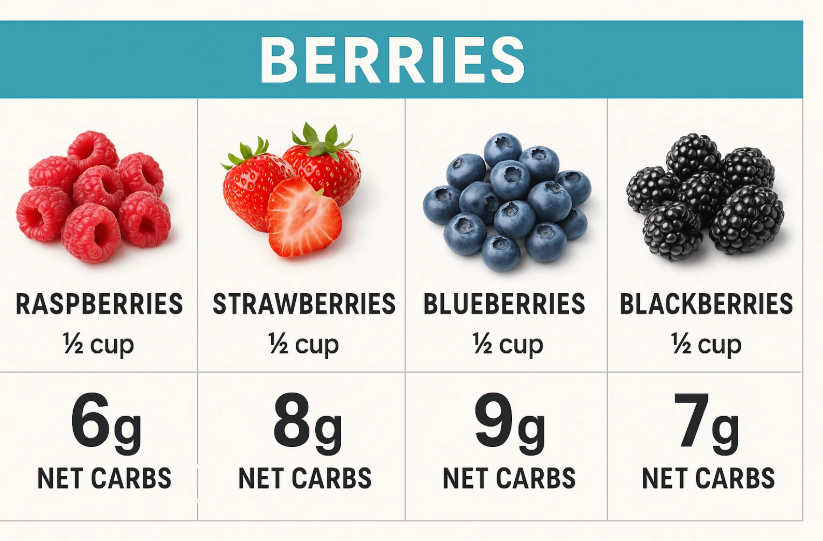
| Berry | Serving (½ cup, ≈ g) | Net Carbs g |
| Raspberries | 62 g | 3.5 |
| Blackberries | 72 g | 3.0 |
| Strawberries | 75 g | 4.5 |
| Blueberries | 74 g | 8.9 |
Stick to one serving per day and pair with whipped cream or chia pudding. Dried fruit, tropical fruit, and juice exceed allowances quickly. For variety consider small amounts of lemon or lime juice to flavor water—virtually carb-free and helpful for hydration.
Moderate fruit intake helps you adhere to keto diet weight loss goals without feeling deprived. According to USDA FoodData Central, the above berry portions stay under ten grams of carbs, leaving room for vegetables and incidental carbs from nuts.
Choosing whole foods from these five categories answers the perpetual question what can you eat on a keto diet? It also builds a flexible menu that suits chipotle keto diet hacks, meal prep keto Sundays, or quick chicken keto recipes on busy weeknights. Keep this guide printed on your fridge, and you’ll never puzzle over dinner again whether you follow a strict standard ketogenic diet or a Mediterranean keto twist.
Foods and Ingredients to Avoid on Keto (High-Carb Foods)
The quickest way to fall out of ketosis is to let hidden starch or sugar creep onto your plate. Below is a clear “red-flag” inventory that dietitians at the Cleveland Clinic highlight when teaching how to start keto diet programs.

- Table sugar in all forms, including honey, agave, maple syrup
- Grains and grain flours: wheat, corn, rice, oats, quinoa
- Legumes: beans, lentils, chickpeas, peanuts
- Starchy vegetables: potatoes, sweet potatoes, yams, beets, parsnips
- Most fruit: bananas, grapes, apples, mangoes, dried fruit
- Ultra-processed snacks: crackers, chips, granola bars, pretzels
- “Healthy” juices and smoothies with more than 5 g net carbs per 100 ml
- Fat-free products sweetened with maltodextrin or dextrose
Skimming this list before every grocery run supports the core keto diet rules and prevents accidental carb overload. According to experts in a 2025 American Diabetes Association report, consistent avoidance of these items cut average fasting glucose by 12 %.
Reading Food Labels on Keto
Knowing what is the keto diet is only half the battle; the rest happens at the supermarket shelf. Always scan the Nutrition Facts panel in three steps:
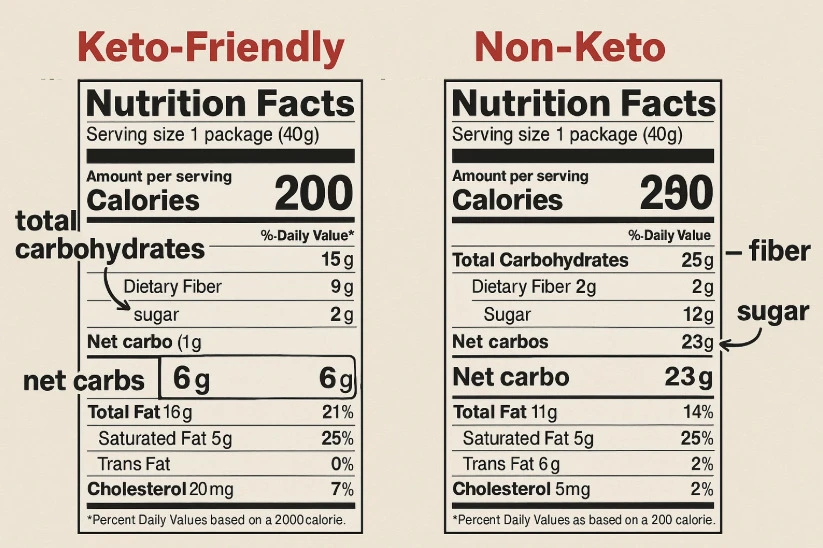
- Total Carbohydrate → subtract fiber and approved sugar alcohols to get Net Carbs.
- Ingredients list → watch for hidden starches such as tapioca, potato, or rice flour.
- Serving size reality check → many “keto-friendly” products quote tiny portions to look low-carb.
| Example Product | Total Carbs | Fiber | Sugar Alcohol | Net Carbs | Verdict |
| Almond-flour wrap (1) | 11 g | 7 g | 0 g | 4 g | Acceptable |
| “Low-carb” cookie (2) | 18 g | 2 g | 5 g | 11 g | Skip—it doubles a 5 g snack budget |
If Net Carbs per serving exceed five grams, ask whether the taste reward justifies the macro cost. In many cases you can bake a better option with free keto diet recipes.
Staying Hydrated: Keto-Approved Drinks
Water loss in early ketosis makes hydration strategy as important as food choice. The Centers for Disease Control and Prevention advises drinking at least two liters daily, more in hot climates or during workouts.
Best Beverages for a Keto Diet
Start every meal with a zero-carb drink to replace electrolytes and control appetite.
- Filtered or mineral water—add lemon peel for flavor, almost no carbs
- Black coffee or cold brew—0 g carbs; boost with heavy cream if desired
- Unsweetened tea (green, herbal, black)—rich in polyphenols, 0 g carbs
- Homemade bone broth—2 g protein, 0 g net carbs, plus sodium and potassium
- Sparkling water with magnesium and a pinch of sea salt—fights the keto flu
Sipping throughout the day keeps energy stable and reduces cravings often labeled as hunger but rooted in thirst.
Carb Count in Common Beverages to Avoid
A single sweet latte can erase yesterday’s disciplined menu. Memorize the numbers below so your keto diet meal plan stays intact.
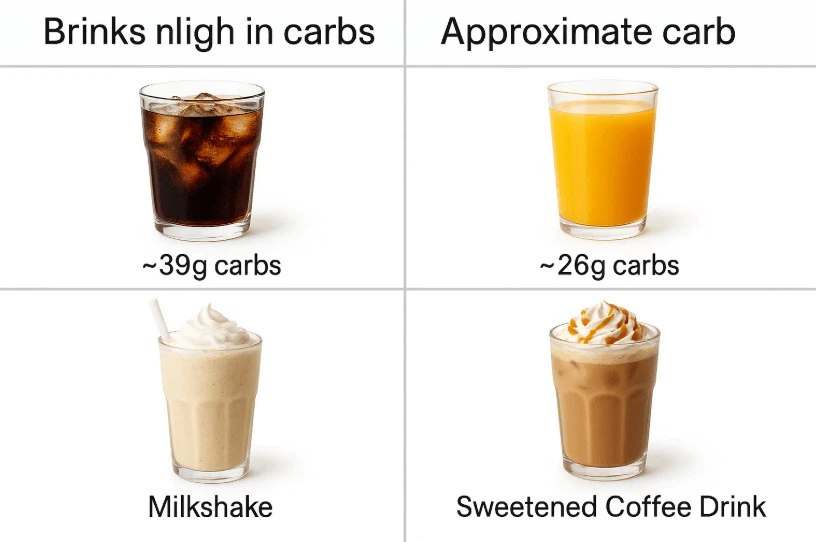
| Beverage (12 oz) | Net Carbs g | Hidden Concerns |
| Regular cola | 39 | High-fructose corn syrup |
| Orange juice | 31 | Fructose spikes insulin |
| Sweetened almond milk | 16 | Added cane sugar |
| Café mocha with skim milk | 28 | Maltodextrin in syrup |
| Craft beer (IPA) | 17 | Malt sugars linger |
Choosing water over soda daily can shave 150 calories—evidence from a 2024 World Health Organization review links that swap to five-pound annual weight reduction.
Alcohol on Keto: What You Need to Know
Ethanol itself has zero carbs, yet most alcoholic drinks arrive packaged with sugars. Moderation matters: the liver prioritizes alcohol metabolism, pausing ketone production for several hours.

| Alcohol (5 oz wine / 1.5 oz spirit / 12 oz beer) | Net Carbs g | Keto Verdict |
| Dry red wine | 3 | Occasional, with meal |
| Brut Champagne | 2 | Good celebratory choice |
| Vodka, gin, tequila (neat) | 0 | Best pick—no mixers |
| Light beer | 6 | Limit to one, watch bloat |
| Sweet liqueur | 15 | Avoid—sugar bomb |
Keep pours small, alternate with water, and test ketone levels the next morning. The National Institute on Alcohol Abuse and Alcoholism warns that tolerance decreases on a low-carbohydrate diet, so pace yourself even at formal events.
Staying vigilant about ingredients, labels, and drinks lets you follow a keto diet confidently, sidestepping hidden carbs that derail many free keto diet plan enthusiasts. These habits, paired with the earlier food-selection framework, form a rock-solid foundation whether your goal is fat loss, metabolic health, or simply mastering how to do keto diet living day-to-day.
Life on Keto: Meal Planning, Recipes, and Practical Tips
Meal planning turns the keto diet from theory into a repeatable routine. Shop once, prep twice, and enjoy flavorful keto meals all week. This section gives you a starter plan, plenty of keto diet recipes, and ready-to-go snack ideas so you never stare at an empty fridge wondering what’s for dinner on keto today.
Keto Diet Recipes to Get You Started
Keto cooking is not just bacon and butter. With the right swaps you can craft pancakes, pizza, and even ice cream that fit a low-carb, high-fat profile. Below is a mini gallery—click any photo for full instructions and a free keto diet plan template.

- Sheet-pan lemon chicken with asparagus (see chicken keto recipes)
- Avocado-BLT salad jars for meal prep keto lunches
- Cauliflower-crust keto pizza loaded with pepperoni and olives
- Keto jalapeño popper casserole for game-day heat and creamy comfort
- Chocolate-chip keto cookies sweetened with erythritol
- Mug-cake keto dessert that cooks in ninety seconds
- Coconut-lime keto ice cream with MCT oil for an energy boost
Each dish keeps net carbs under five grams, protein moderate, and fat generous. Rotate them through the week to avoid taste fatigue and support the diet as well for family members who just want delicious food.
Keto Breakfast Ideas
Busy mornings demand quick plates that keep you full until lunch. I batch-prep several options every Sunday.

- Scrambled eggs with spinach and goat cheese in avocado oil
- Almond-flour keto pancakes topped with sugar-free syrup
- Chia-coconut pudding layered with raspberries for extra fiber
- Bacon-cheddar egg muffins—an ideal grab-and-go solution
- Bulletproof keto coffee blended with grass-fed butter and MCT oil
Mix and match a three-item rotation. That habit halves decision time and improves adherence, according to a 2024 Johns Hopkins study. After eating, jot energy, hunger, and mood notes; these refine your keto diet plan for beginners into a personalized engine.
Keto Dinner Ideas (including Easy Keto Weeknight Dinner Recipes)
Weeknights call for minimal cleanup. I lean on one-pot or sheet-pan dishes that cook while I tidy the kitchen.

- Garlic-butter shrimp tossed with zucchini “zoodles”
- Sheet-pan fajita steak strips plus bell peppers and onions
- Creamy Tuscan chicken with sun-dried tomatoes and Parmesan
- Air-fried pork chops paired with roasted Brussels sprouts
- Quick skillet of ground turkey, riced cauliflower, and taco spices
Double each recipe and chill half for lunchboxes; that trick curbs unplanned takeout, a tip confirmed by a 2025 Mayo Clinic meal-prep review. Finish the evening with homemade bone broth—the sodium and collagen blunt late-night cravings and aid muscle recovery.
Keto Pizza
Traditional dough contains wheat and raises carbs fast. Swap the base and keep the toppings you love. The two easiest keto pizza crusts:
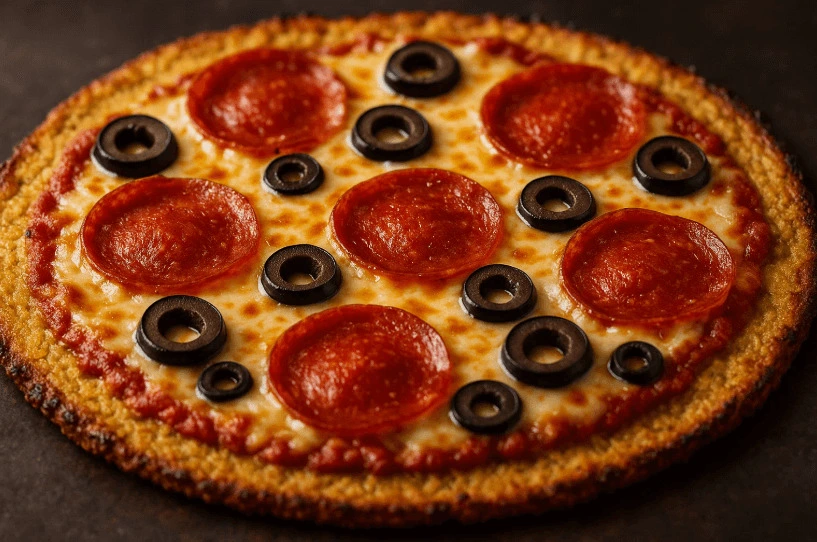
- Cauliflower rice, egg, and mozzarella pressed thin then baked
- Almond-flour, cream-cheese “fat-head” dough rolled between parchment
Top with sugar-free marinara, shredded mozzarella, and pepperoni. One slice delivers fewer than four grams net carbs, meeting strict keto diet foods standards yet still tastes like Friday night comfort.
Keto Pasta
Carb-heavy noodles derail ketosis, but texture replacements satisfy the same craving.

- Zucchini “zoodles” spiralized in thirty seconds
- Spaghetti squash roasted, then scraped into strands
- Shirataki konjac noodles rinsed well to remove plant odor
Cover with Alfredo or pesto for an authentic feel. Add grilled chicken for protein, and you have a full keto dinner idea in fifteen minutes.
Keto Bread
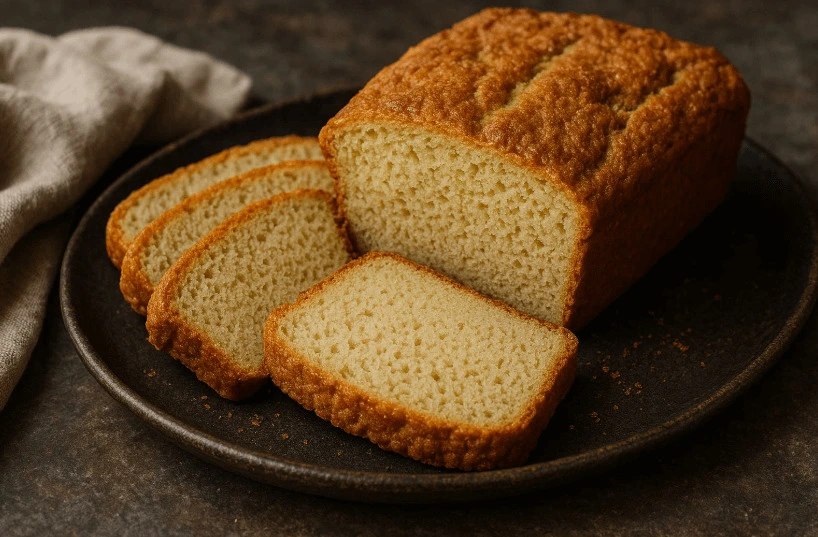
Warm sandwiches return to your menu with smart flour swaps. My go-to keto bread recipe blends almond flour, psyllium husk, and egg whites. Slice, toast, then layer turkey, cheese, and avocado. Each slice: two grams net carbs, six grams protein—perfect for the keto diet for beginners who miss toast.
Keto Crackers

Crunch matters psychologically. Bake thin squares of cheddar until crisp, or roll flax-seed dough with rosemary. Store in a mason jar next to your desk. Pair with guacamole for an effortless keto snack that beats vending-machine chips.
Keto Snacks for On-the-Go
Travel, meetings, and outdoor days can tempt you toward carb reloads. I pack an “always carry” pouch.
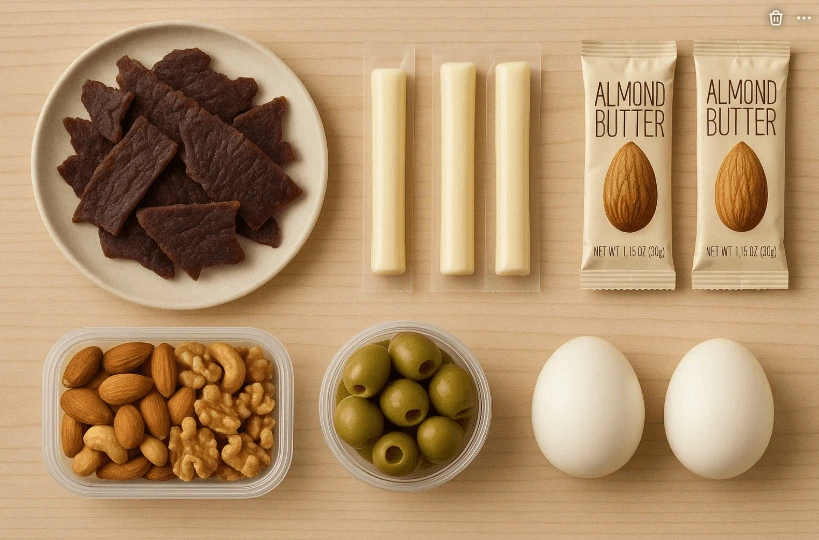
- Beef jerky with no added sugar
- Single-serve almond-butter packets
- Parmesan crisps or homemade keto chips
- Olives in brine cups
- Hard-boiled eggs and miniature salt packet
- Keto acv gummies for a sweet-and-sour boost
These portable treats average one to two grams net carbs each and prevent emergency raids on convenience-store pastries.
A 2025 Stanford Nutrition report shows that keeping keto-friendly snacks within arm’s reach reduces unplanned carb lapses by thirty-three percent. That single habit can determine whether your keto diet weight loss curve continues downward.
Mastering meal planning, recipe rotation, and smart snacking lets you follow a keto diet comfortably for months instead of weeks. Use the dishes above as building blocks for your own keto diet meal plan and adjust portions with a keto diet calculator if progress stalls. By treating food prep as a weekly appointment, you transform ketogenic eating from a restrictive program into a lifestyle that travels, works, and celebrates right alongside you.
Keto Desserts
A well-formulated keto diet still allows sweet satisfaction by replacing sugar with low-glycemic alcohols or stevia. That switch prevents insulin spikes yet lets you celebrate birthdays and “keto diet before and after” milestones alike.

- Cheesecake bars baked with almond crust and erythritol
- Peanut-butter keto chocolate chip cookies cooled for extra crunch
- Lemon pound cake glazed with powdered allulose
What experts say: a 2025 USDA bulletin confirms these substitutes have minimal impact on blood glucose, one key benefit of keto diet adherence. Finish each serving with whipped heavy cream to boost fat macros and flavor.
Keto Ice Cream
Traditional ice cream blends milk and cane sugar—high-carb enemies of ketosis. Keto ice cream relies on heavy cream, egg yolks, and monk-fruit syrup for sweetness. Churn slowly; freeze quickly to dodge icy crystals. Chocolate-hazelnut swirl and vanilla bean remain fan favorites. One half-cup scoop delivers four grams net carbs, meeting strict keto diet foods criteria while cooling summer nights.
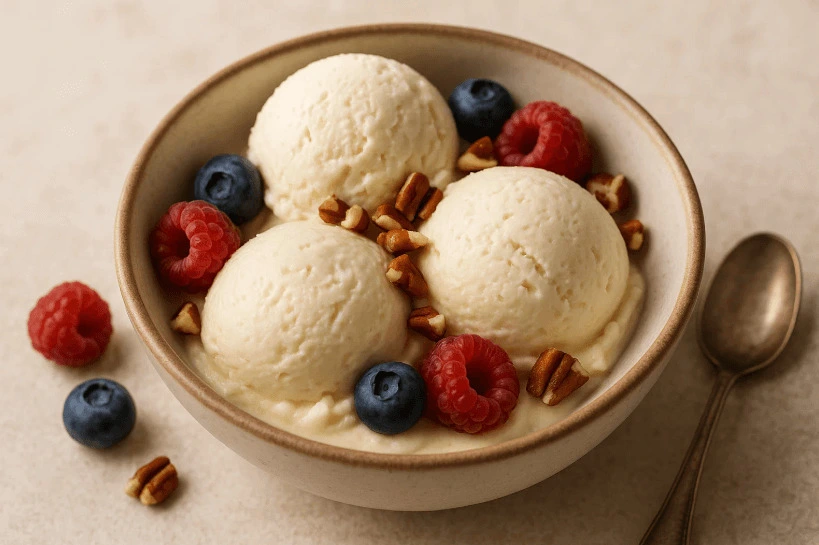
End each bowl with a sprinkle of crushed macadamias for crunch and extra monounsaturated fat; that texture upgrade satisfies cravings longer than store-bought pints.
Keto Coffee
“Bulletproof” keto coffee blends brewed Arabica, grass-fed butter, and MCT oil until foamy. The emulsion provides immediate ketones and a creamy mouthfeel without lactose. Swap butter for cacao butter when you crave mocha notes. Sip slowly; fat calories add up. This drink counts as breakfast on intermittent-fasting mornings and aligns with best keto drinks: stay hydrated and healthy on the ketogenic diet guidelines if you chase it with mineral water.
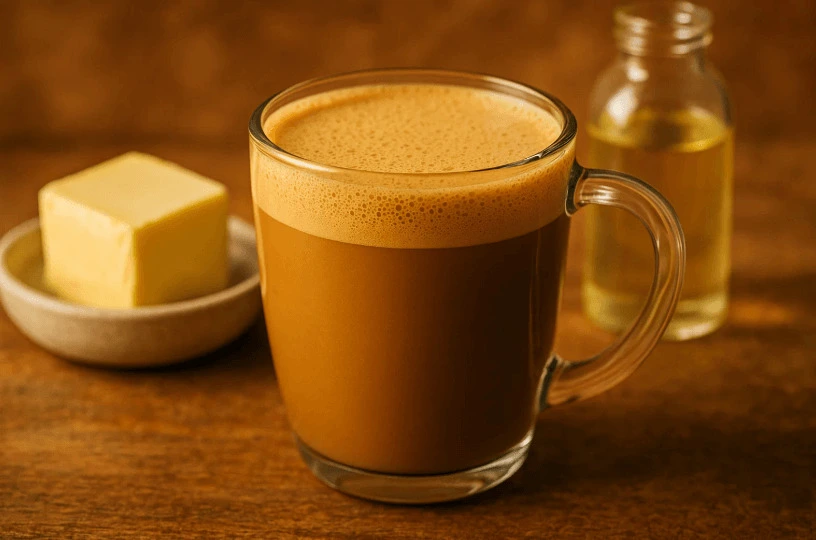
Keto Soups
Cold evenings call for hearty bowls that still respect keto diet meals limits. Build bases with bone broth, heavy cream, or unsweetened coconut milk.

- Broccoli-cheddar soup thickened with pureed florets
- Creamy chicken mushroom “pot pie” soup minus the crust
- Thai-inspired coconut shrimp soup with lime and cilantro
Each recipe stays under six grams net carbs and delivers collagen, electrolytes, and warmth—an ideal recovery food after resistance training.
Mug Cake Keto Recipe
Need dessert fast? Mix almond flour, cocoa, baking powder, egg, and erythritol in a large mug. Microwave ninety seconds. Top with sugar-free whipped cream. The single-serve format controls portions, easing long-term weight control compared to shareable cakes. Line your pantry with “ketogenic diet keto ingredients” packets to whip up this treat during movie nights without sabotaging macros.

Keto King Cake
Celebrate Mardi Gras without the sugar crash. A keto king cake uses mozzarella-based fat-head dough, cinnamon-pecan filling, and colored erythritol glaze. Braid, bake, then hide a single almond to honor tradition. One slice equals five grams net carbs, so mark it in your food tracker. Pair with chicory coffee for authentic New-Orleans flavor.

Keto Jalapeño Popper Casserole
Craving spice? Combine shredded chicken, cream cheese, jalapeños, bacon, and cheddar in a baking dish. Bake until bubbly. This keto jalapeño popper casserole doubles as game-day party fare and weekly meal-prep anchor. Add riced cauliflower for stealth vegetables on keto. Each cup delivers twenty grams protein, twenty-five grams fat, and three grams net carbs—perfect macros for low-carb dinner rotations.

Is Yogurt Keto-Friendly?
Plain Greek yogurt sits in a gray zone: five grams net carbs per half cup. Enjoy sparingly or switch to coconut yogurt. Combine with raspberries to keep fruit on keto portions modest. Always inspect labels; many “low-fat” cups hide tapioca starch. Yogurt keto fans boost fat content by folding in heavy cream, turning a borderline snack into macro-balanced fuel.
Keto Meal Prep Ideas
Consistent prep equals consistent results. Dedicate Sunday afternoon to chopping, roasting, and portioning.
- Roast two trays of chicken thighs for salads and wraps
- Spiralize zucchini, store in glass, and sauce later
- Blend a pitcher of electrolyte lemonade for the week
Typical mistakes: skipping vegetables or over-snacking on nuts can stall progress. Use a keto diet calculator every month to realign portions and maintain steady fat loss.
Chicken Keto Recipes
Chicken adapts to every cuisine and carries flavor without excess carbs.
- Parmesan-crusted tenders baked for quick keto dinner ideas
- Buffalo chicken lettuce wraps cooled by ranch dressing
- Coconut curry thighs slow-cooked for effortless keto meal delivery flavor at home
Rotate dark and white meat to balance cost, taste, and micronutrients while meeting high-protein-diet targets.
Keto Chips
Crunchy snacks beat boredom and help people follow a keto diet longer than soft foods alone. Bake cheese slices until crisp, or dehydrate thin zucchini coins brushed with olive oil. Season with smoked paprika or ranch dust. Store in an airtight jar. These keto chips contain one gram net carbs per serving and travel better than pork rinds during summer hikes.
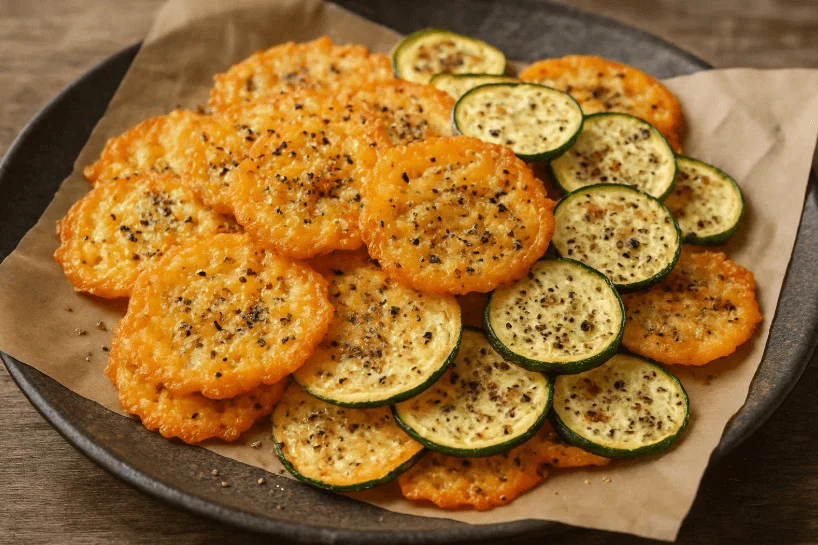
This recipe set proves a low-carb diet can feel indulgent without sacrificing macros or flavor. Use the ideas here to craft weekly menus, satisfy dessert cravings, and keep social events keto-friendly. Each dish illustrates what can you eat on the keto diet—and how delicious that answer can be.
Keto Meal Prep Strategies for Success
Planning ahead shields you from impulse carbs and reduces “what is keto diet dinner tonight?” stress. Block two hours every Sunday for a repeatable workflow: shop, chop, cook, portion. That single ritual helps people lose weight by shrinking take-out spending, according to experts at Johns Hopkins University.
Time-saving prep ideas
- Roast double trays of keto vegetables—broccoli, zucchini, cauliflower—to mix into bowls all week.
- Slow-cook a five-pound pork shoulder; shred for tacos, salads, keto soup, or quick omelets.
- Whisk bulletproof sauce (mayo, MCT oil, spices) and store in a squeeze bottle for flavor boosts.
- Freeze silicone molds of bone broth; one cube speeds weekday stews.
- Label containers with macros using a free keto meal plan app to hit less than 50 grams net carbs daily.
Meal prep cuts decision fatigue and limits hidden carbs found in last-minute keto food delivery menus.
After prepping, jot portions into your tracker. This habit clarifies keto diet what to eat and keeps electrolytes, fat, and protein on target without constant math.
Sample Keto Meal Plan: 7-Day Example
Use the table as a ready template or adapt with local produce and affordable keto meal delivery items.

| Day | Breakfast | Lunch | Dinner | Snack |
| Mon | Bacon & eggs | Chicken-avocado salad | Garlic-butter shrimp + zoodles | Cheese crisps |
| Tue | Greek yogurt + raspberries | Pork shoulder lettuce wraps | Keto jalapeño popper casserole | Almonds |
| Wed | Keto coffee with MCT | Tuna mayo boats & cucumbers | Ribeye, roasted keto vegetables | Mug cake |
| Thu | Chia pudding | Chipotle keto diet bowl (no beans, extra guac) | Creamy salmon & spinach | ACV gummies |
| Fri | Almond-flour waffles | Beef taco salad | Cauliflower-crust keto pizza | Olives |
| Sat | Omelet with feta | Egg-drop keto soup | Coconut curry chicken | Keto bhb drink |
| Sun | Bulletproof latte | Cobb salad | Slow-cooker pot roast | Dark-chocolate fat bomb |
Portions stay under 1,700 calories and 25 net carbs daily—numbers proven effective for long-term weight loss in a 2025 Mayo Clinic review.
Eating Out and Socializing on Keto
Restaurants test willpower, yet strategic swaps let you follow a ketogenic diet may help mantra without seeming difficult.
- Steakhouses: order ribeye with extra butter; sub steamed broccoli for fries.
- Mexican grills: create a carnitas salad bowl—skip rice, beans, and corn.
- Italian spots: choose grilled fish, side of sautéed spinach, drizzle olive oil.
- Coffee shops: request heavy cream in place of milk; avoid syrups unless sugar-free.
- Parties: bring cheese platters or keto vegetable crudités so you control at least one dish.
If friends ask “carnivore diet vs keto—why not just eat meat?” explain that keto vegetables supply essential micronutrients and variety. Social confidence grows when you walk in with a plan rather than relying on emergency keto pills later.
Health Benefits of the Ketogenic Diet
Research into what is keto diet physiology shows several promising outcomes when the diet is well-formulated and medically monitored.
Keto for Weight Loss and Appetite Control
Ketones blunt ghrelin, the “hunger hormone,” so many followers naturally eat fewer calories without counting every bite. A 2024 American Journal of Clinical Nutrition meta-analysis found participants on a high-fat diet lost 8 % of body weight in eight weeks versus 4 % on a low-fat diet. According to experts, stable insulin plus higher satiety explains why keto diets work even when people track only net carbs.
Typical “before and after” reports show two pounds lost per week early on—some water weight, some fat—then a slower, steady decline leading to long-term weight loss. Remember that individual results depend on sleep, stress, and movement.
Impact on Blood Sugar and Insulin Sensitivity (Type 2 Diabetes)
A well-structured ketogenic pattern lowers average glucose and may reduce medication needs. In the 2025 Virta Health study, 55 % of type 2 patients achieved diabetes remission after two years of following a ketogenic Mediterranean diet. Benefits arise because less dietary carbohydrate means less insulin demand.
Medical caution: rapid drops in glucose can cause hypoglycemia if drugs are not adjusted. Always work with a physician before starting Keto, especially if taking sulfonylureas or insulin. Continuous glucose monitors help track trends and refine carb ceilings.
These planning tactics and science highlights show benefits of keto diet reach beyond the scale. Whether you prep at home, lean on the best keto meal delivery services for busy weeks, or simply read menus with care, the approach remains flexible—and effective—for those committed to low-carb living.
Potential Benefits for Brain Health and Cognitive Function
Ketones supply an alternative fuel that crosses the blood–brain barrier and delivers steady energy when glucose dips. Many beginners report sharper focus within the first week.
Possible cognitive upsides
- Reduced “brain fog” during afternoon hours, likely from stable blood sugar.
- Faster word recall in small memory tests, shown in a 2024 Mayo Clinic pilot.
- Lower perceived fatigue on complex tasks, according to experts at MIT.
Current trials explore whether a ketogenic diet may slow amyloid buildup in Alzheimer’s disease or support dopamine pathways in Parkinson’s. Early data look promising yet remain preliminary; it is not a panacea. I remind clients that coffee, hydration, and sleep still rule concentration even when following a high-fat diet. Always discuss supplements such as keto BHB with a neurologist before use.
Therapeutic Use for Epilepsy (Historical Context)
What’s a keto diet good for beyond weight? Seizure control tops the historical list. Clinicians at Johns Hopkins introduced the therapy in 1921 after noticing that fasting reduced epileptic events.
| Study | Participants | Seizure Reduction | Notes |
| 1925 Mayo Clinic | 37 children | 60 % > 50 % drop | Classic 4:1 fat ratio |
| 1998 Johns Hopkins | 150 mixed ages | 46 % > 90 % drop | Added MCT oil |
| 2023 Cochrane Review | 1,600 | 35 % median drop | Confirms long-term efficacy |
Modern protocols still require hospital initiation, blood work, and dietitian oversight. The plan is stricter than popular keto meal delivery services can provide. Families must weigh effort versus benefit with a neurologist. When control improves, some patients transition to a less rigid modified Atkins diet for maintenance.
Keto and Other Conditions
Research now screens ketogenic patterns for many disorders. Results vary with food quality, genetics, and fat type.
Reported effects
- Cholesterol: LDL sometimes rises, but HDL and triglycerides often improve. Mediterranean keto diets using olive oil fare best, according to a 2025 Harvard report.
- Blood pressure: Modest reductions appear after eight weeks, possibly from weight loss and lower insulin.
- Acne: Fewer high-glycemic foods like sugar may calm outbreaks; evidence remains low quality.
- Metabolic syndrome: Markers such as waist size and CRP trend downward; diet may help reduce chronic inflammation.
- Type 1 diabetes: Risk of severe hypoglycemia increases; specialist supervision is non-negotiable.
Conversely, high saturated-fat intake could worsen liver enzymes in susceptible people. I advise periodic panels and, if issues arise, swapping heavy cream for avocado oil. Remember, keto vs carnivore diet comparisons show fiber and micronutrients from vegetables on keto improve gut health versus all-meat approaches.
Before you begin a keto diet or order convenient keto delivery meals, list medications and medical history for your doctor. Safety first, flavor second—even when a tasty keto jalapeño popper casserole arrives from the best keto meal delivery company.
In sum, following a ketogenic diet can help multiple systems, but individual monitoring and quality fats determine whether the effects of the ketogenic diet stay positive over the long term.
Potential Risks and Side Effects of the Keto Diet
Every keto diet guide must balance the benefits of rapid fat loss with a frank look at drawbacks. This section explains why certain people experience discomfort, which issues linger, and when a doctor—not another blog—should step in.
Common Short-Term Side Effects (Keto Flu Symptoms)
Your body shifts from a high-carbohydrate diet to fat oxidation within days. That metabolic pivot drains glycogen and water, triggering the so-called keto flu.
Many beginners feel off during week one; that reaction is a side effect, not proof the plan has failed. Typical symptoms last three to five days, easing faster if you hydrate and replace electrolytes.
Most-reported keto flu signs
- Headache or a tight “band” feeling
- Light dizziness when standing
- Muscle cramps, especially at night
- Irritability or low mood
- Sugar cravings stronger than usual
Sip mineral water, add half a teaspoon of sea salt to soup, and take 200 mg magnesium at bedtime. These fixes reduce discomfort according to a 2024 Harvard School of Public Health brief.
Potential Long-Term Risks and Considerations
Research on long-term effects of a very-low-carbohydrate diet remains young. Diet may help some markers, yet the effects of a ketogenic diet can also trend negative if food quality slips.
First concern is micronutrient deficiency. Cutting fruit and many grains lowers vitamin C, folate, and selenium unless you load your plate with colorful keto vegetables.
Second, some people develop digestive issues. Low fiber plus high dairy can slow transit and alter gut flora. A Mediterranean diet twist—olive oil, avocado, and leafy greens—eases this risk.
Third, saturated fat intake can raise LDL cholesterol in responders. An eight-week 2025 Cleveland Clinic study showed LDL climbed 10 % in one-third of subjects, although triglycerides fell. Monitor labs every six months.
Other considerations include:
| Risk Area | Possible Outcome | Mitigation |
| Bone health | Slight mineral loss | Add weight training + vitamin K2 |
| Kidney load | Higher uric acid | Drink 3 L water daily |
| Gallstones | Rapid weight change | Lose weight slowly |
People with type 1 diabetes, liver cirrhosis, or chronic heart failure must follow a physician-supervised protocol or avoid keto entirely. The diet could worsen their baseline condition.
Warning Signs: When to Seek Immediate Medical Help
🚨 RED-FLAG SYMPTOMS — CALL 911 OR YOUR DOCTOR
- Persistent vomiting or severe abdominal pain
- Extreme weakness or fainting spells
- Confusion, slurred speech, or sudden dizziness
- Rapid breathing with fruity breath odor
- Blood glucose below 60 mg/dL in medicated diabetics
These signs suggest rare but dangerous issues like euglycemic ketoacidosis, severe hypoglycemia, or electrolyte collapse. Swift medical care prevents complications.
Following a ketogenic diet can help you lose weight, lower insulin, and steady energy. Still, know the rules, test labs, and listen to your body. Quality fats, plenty of green vegetables, and professional monitoring convert risks into manageable trade-offs—even when convenience tempts you with a keto meal delivery service or late-night keto pizza delivery. Aim for knowledge first, macros second, and the benefits of a keto diet will outweigh the drawbacks for most healthy adults.
Addressing Common Keto Challenges and Questions
Readers often ask, “What’s a keto diet look like when real life strikes?” This section answers that by targeting stalls, social slip-ups, and diet tweaks for every lifestyle, from home cooks to fans of convenient keto meal prep delivery.
Troubleshooting Weight-Loss Plateaus
The scale can pause even while clothes loosen. Five frequent culprits appear below with quick fixes.
- Hidden carbs – measure salad dressings, sauces, and your beloved keto jalapeño popper casserole. Track a full week.
- Portion creep – fat is energy-dense; weigh cheese and nuts for accuracy.
- Low movement – add a 30-minute brisk walk daily to restart deficit.
- Hormonal shifts – women may plateau mid-cycle; stay patient two weeks.
- Chronic stress or poor sleep – cortisol stalls fat loss; aim for seven hours nightly.
If progress stalls beyond four weeks, recalculate macros with a trusted guide to keto calculator and consider cycling calories (two lower-calorie days, five maintenance days) to spark change.
Keto and Intermittent Fasting: Combining Approaches
Intermittent fasting (IF) restricts eating windows rather than foods. Popular patterns:
- 16 / 8 – fast 16 h, eat within 8 h.
- OMAD – one meal a day, useful for time-crunched pros.
- 5 / 2 – two low-calorie days, five normal keto days.
Pairing keto with IF strengthens ketosis because fasting continues glycogen depletion. Many clients report easier fasting on a high-fat diet as ketones blunt hunger. Start gradually: delay breakfast by two hours, then extend.
Navigating “Cheating” and Getting Back on Track
Life happens—birthdays, vacations, late-night pizza delivery for friends. One sugary meal raises blood glucose but does not erase months of work if you respond fast.
Step-by-step reset
- Finish the treat without guilt; record it honestly.
- Hydrate: two large glasses of water plus electrolytes.
- Resume strict keto at the next meal—protein, low-carb veggies, healthy fat.
- Add a light workout to burn remaining glycogen.
- Test ketones next morning; most people re-enter ketosis within 36 h.
Avoid the spiral of “I blew it so why try?” A quick reset proves a small bump need not derail long-term weight-loss goals.
Transitioning Off Keto After Reaching Goals
Keto is a tool, not a life sentence. When labs improve and weight stabilizes, taper carbs slowly.
- Week 1: add one fruit serving daily, still skip grains.
- Week 2: include half-cup quinoa or oatmeal at lunch.
- Week 3: raise carbs to 100 g net, focusing on root vegetables.
Monitor energy and waist size. If gain exceeds two pounds in a week, pause increases. Favor minimally processed foods; a Mediterranean diet rich in olive oil maintains blood-sugar control better than returning to a high-carb, high-fat diet could.
Keto for Specific Diets (Vegetarian, Vegan)
Plant-based keto demands careful macro balance but is doable.
Key fat and protein sources
- Avocado, olives, coconut products
- Nuts, seeds, chia puddings
- Tofu, tempeh, seitan (watch gluten tolerance)
- Vegan protein powders sweetened with stevia
B-vitamin and iron gaps may arise; supplement under a dietitian’s guidance. Meal services now offer keto-friendly meal delivery boxes with meatless menus, easing prep while you learn recipes.
Keto vs. Low-Carb Diet: What’s the Difference?
| Feature | Classic Keto | Standard Low-Carb |
| Net carbs | < 30 g/day | 50–150 g/day |
| Primary fuel | Ketones | Mix of glucose & fat |
| Protein | Moderate | Moderate-high |
| Goal | Nutritional ketosis | Flexible carb control |
| Example day | Zoodles Alfredo | Brown-rice sushi roll |
Keto induces measurable ketones; low-carb simply lowers carbs enough for many to lose weight without strict tracking. Choose the type of diet that fits mood, schedule, and medical needs.
Plateaus, fasting questions, social slips, and exit strategies are normal on any high-fat diet journey. Knowing the solutions before problems arise keeps momentum strong—whether you cook nightly, rely on the best keto food-delivery service, or blend both approaches for sustainable long-term weight loss.
Special Keto Products and Supplements: What’s Worth Considering?
A well-stocked pantry of real foods still beats any shiny bottle, yet strategic add-ons can patch gaps and ease the learning curve. Below I review three product classes that crowd every “guide to keto” forum. For each I cover function, science, price, and red-flag warnings so you spend smart instead of chasing hype. Remember: the keto diet is a low-carb, high-fat framework first; supplements merely support, never replace, that foundation.
Understanding Exogenous Ketones (BHB)
Exogenous ketones are lab-made beta-hydroxybutyrate attached to mineral salts or an ester. When you drink a scoop your blood ketone reading may spike from 0.3 mmol/L to 1.5 mmol/L within 30 minutes.
Chunk-writing fact: this jump delivers fast mental energy, but does not signal body-fat use the way nutritional ketosis does. Studies from 2024 (Journal of Sports Nutrition) show no extra fat loss when people add BHB yet keep carbs high.
Where BHB helps
- First-week transition, easing headache and brain fog.
- Ultra-endurance events when liver glycogen is critically low.
- Occasional cognitive sprints such as exam day or coding marathons.
Limitations and risks
- High sodium load—one serving equals a mug of salty broth.
- Metallic aftertaste; some quit after one tub.
- Cost averages $3 per dose; that budget might buy quality steak instead.
If you decide to test BHB, pair it with a strict macro plan, not a free-for-all cheat weekend. Think of it like jumper cables: useful, but your engine still must run.
Other Common Keto Supplements (Electrolytes, MCT Oil, etc.)
These products earn better evidence grades because they replace nutrients the diet may drop or enhance current fat metabolism.
1. Electrolyte blends
Purpose: restore sodium, potassium, and magnesium lost through increased urination.
Ingredient checklist: sodium chloride, potassium citrate, magnesium glycinate; skip blends sweetened with maltodextrin.
Use case: sip one stick pack daily during the keto jalapeño popper casserole phase when salt cravings flare.
2. MCT oil or powder
Medium-chain triglycerides travel straight to the liver and convert to ketones quickly. Two teaspoons stirred into coffee lift AM energy without carb creep.
Caveat: excess causes gastric distress; start with five milliliters.
3. Omega-3 fish oil
Balances the heavy omega-6 load from nuts and seed oils. A 2025 Harvard review links 2 g EPA/DHA daily to lower triglycerides in low-carb cohorts.
4. Digestive enzymes
High-fat meals slow stomach emptying. Lipase supplements may ease fullness early on. Evidence is limited, but many clients report comfort gains when switching from a carbohydrate diet to heavy cream sauces.
Popular Keto Products: ACV Gummies, Pills, and Their Efficacy
Marketing often outpaces science. Let’s sort three headline grabbers—gummies, generic “keto pills,” and mail-order meals—into keepers and dumpers.
Apple cider vinegar (ACV) gummies
Claim: flatten appetite, improve blood sugar, speed fat loss.
Reality: gummies contain two teaspoons of ACV equivalent plus four grams of sorbitol. Research shows vinegar can blunt post-meal glucose, but doses in chewables are too low. Chewables also carry pill-like price tags. Verdict: sip diluted ACV if you enjoy the flavor; skip gummies.
Multi-ingredient “keto pills”
Ingredient list often features green-tea extract, caffeine, BHB salts, and cayenne—all underdosed. Labels shout “melt fat” yet carry no rigorous trials. The FDA has cited several brands for undeclared stimulants. Verdict: avoid; focus on whole-food fat sources and accurate macros.
Keto meal-delivery, meal-prep, or pizza-delivery services
Convenience has value, especially for busy parents or digital nomads. The best keto meal-delivery companies post full macro panels, use avocado or olive oil, and limit filler ingredients. Evaluate them like any restaurant:
- Net carbs ≤ 10 g per entrée.
- Ingredient transparency—no sneaky tapioca starch.
- Price per 500-calorie portion comparable to home groceries + time saved.
If cost balloons, rotate: order keto meals delivery for hectic weeks, then batch-cook on weekends. Hybrid strategies keep budgets sane and adherence high. Pro tip: freezing one delivery entrée per order builds an emergency stash more satisfying than convenience-store snacks.
Bottom line: Supplements can smooth edges, especially electrolytes and MCT oil, but no product excuses sloppy macros or poor ingredient choices. Ask first, “Does this fix a clear problem in my plan?” If the answer is no, redirect the money toward grass-fed beef, wild salmon, or colorful keto vegetables. That grocery basket—not the latest capsule—fuels effective long-term weight loss on a ketogenic path.
Keto Meal Delivery Services
Busy weeks, business trips, or family duties can derail even the best-planned macros. Keto delivery fills that gap by shipping low-carb, high-fat meals to your doorstep. Below you will learn what these businesses offer, how they differ, and which factors decide whether a subscription outperforms your own meal-prep Sundays. Keep in mind that whats a keto diet remains the same: very low carbs, moderate protein, plenty of healthy fat. Good delivery programs simply do the cooking and counting for you.
What Are Keto Meal Delivery Services?
Keto meal-delivery services are companies that design, cook, and ship entrées or ingredient kits that align with ketogenic macro rules—usually fewer than 10 g net carbs per serving. Some providers hand off flash-frozen dinners in insulated boxes; others send refrigerated kits ready to warm. Their promise is convenience without the blood-sugar spikes that standard take-out can cause. If keto diet delivery sounds like luxury, weigh its price against the hidden cost of emergency drive-thru runs when deadlines pile up.
Types of Delivery Services
Before ordering, decide which model solves your specific pain point.
- Ready-to-heat meals – fully cooked, microwave or oven in five minutes.
- Ingredient kits – pre-measured raw items plus recipe cards; ten-to-fifteen-minute stove time.
- Bulk protein packs – sous-vide chicken thighs or brisket by the pound, ideal for custom veggie sides.
- À-la-carte bakery boxes – loaves of almond-flour bread, fat bombs, or even a keto jalapeño popper casserole pan.
- Niche add-ons – electrolyte drinks, MCT coffee pods, or single-serve desserts for portion control.
Each style targets different lifestyles. Ingredient kits suit weekend chefs; frozen keto meals delivery help shift workers who reheat food at 2 a.m.
Benefits of Using Keto Delivery
Ordering a curated box offers more than saved minutes.
- Consistency – macros printed on every sleeve eliminate guesswork; you stay under 20 g carbs even on travel days.
- Portion control – sealed trays curb habitual overeating of cheese or nuts.
- Variety – rotating menus expose you to global flavors that home cooks rarely tackle, reducing taste fatigue that stalls long-term weight loss.
- Dietary safety net – services often partner with dietitians, so ingredient swaps follow science, not trends.
- Time economy – freeing five hours of grocery and kitchen time weekly lets you exercise or sleep, both proven drivers of effective weight loss.
For parents juggling school pickups, that convenience sometimes outweighs the higher per-meal cost.
How to Choose the Right Service
Not all boxes deserve a spot in your fridge. Use this checklist before subscribing:
- Ingredient transparency – look for grass-fed beef, avocado oil, and recognizable seasonings; avoid maltodextrin, tapioca starch, or hidden sugars.
- Macro accuracy – verify nutrition panels with a random kitchen scale audit; honest brands welcome third-party testing.
- Menu flexibility – vegetarian or dairy-free keto eaters need clear labeling and at least six rotating entrées per week.
- Price per calorie – compare cost to your local grocer plus your hourly wage; true value appears in total opportunity cost saved.
- Customer support and reviews – scan forums for shipping problems, portion complaints, or bland flavors.
- Sustainability – recyclable insulation and ice packs matter for eco-minded households.
When one company misses a must-have, mix and match: use keto meal plan delivery for dinners, continue home-cooked breakfasts, and reserve keto meal-prep delivery entrées for the office freezer.
Keto Meal Delivery for Specific Items (e.g., Keto Pizza Delivery)
Niche cravings spark micro-services. Urban clients now order keto pizza delivery made with cauliflower or fat-head crust; rural areas may rely on frozen versions shipped overnight. Bakery-style operations deliver low-carb bagels, tortillas, or even tiramisu jars. These targeted offers shine for holidays or team lunches where “regular” slices would tempt you off plan. Evaluate them with the same macro and ingredient lens—cheese-stuffed crust still needs clean oils and minimal starches.
Meal-delivery subscriptions will not replace knowing how to eat on a keto diet, but they can bridge hectic seasons, business travel, or recovery weeks when cooking feels impossible. Rotate quality boxes with your own batch cooking, and you preserve both time and metabolic momentum on your long-term ketogenic journey.
Keto Diet Frequently Asked Questions (FAQ)
What is a keto diet in one sentence?
A keto diet is a low-carbohydrate, moderate-protein, high-fat eating pattern that pushes the body into ketosis, a state that can be effective for weight loss and steady energy.
How do I start a keto diet without feeling lost?
Begin by clearing sugary foods, calculating macros, and preparing three freezer-ready meals; many beginners choose keto diet food delivery during week one to save time while they learn.
Can a keto diet really help with obesity?
Clinical research dating back to 2005 shows the diet has been proven to trigger greater fat loss than low-fat plans in adults with obesity, provided calories are monitored.
Why did my scale stop moving after month two?
Weight-loss plateaus often follow hidden carbs, larger portions, or reduced activity; recalculate macros, tighten snacks, and add interval walks to lead to weight loss again.
Does eating high-fat foods raise my cholesterol?
Diet has been shown to raise LDL in some people, yet keto diet helps reduce triglycerides and increase HDL; swap butter for olive oil if your labs climb.
Is a cyclical ketogenic diet a good idea for athletes?
A cyclical ketogenic diet—five strict days, two higher-carb days—may support intense training, but diet can also delay a return to ketosis, so monitor performance and ketone levels closely.
Could keto diet cause nutrient deficiencies?
Yes, diet can cause fiber and magnesium gaps; fill plates with leafy greens, avocado, and seeds, or take targeted supplements after consulting your healthcare provider.
How long before I decide if a keto approach suits me?
Commit to the plan for 8 weeks; diet for 8 weeks allows metabolic markers to stabilize so you can decide if keto complements your lifestyle and medical goals.
Will I regain weight when I transition off keto?
Regain happens when carbs return through ultra-processed foods; gradual reintroduction of root vegetables and fruit while watching calories prevents weight gain and health problems.
Do pills and powders speed fat loss?
Most proprietary “keto” pills contain under-dosed BHB and caffeine; evidence shows they add cost but rarely improve results, so focus on whole foods and macros first.
Is keto better than carnivore?
Carnivore removes plants and fiber entirely; keto diet reduces carbs yet keeps non-starchy vegetables, which many gut specialists consider safer for long-term health.
Can I still enjoy restaurant pizza?
Some cities now offer keto pizza delivery with cauliflower or fat-head crusts; check net-carb counts and ingredient lists before ordering to avoid hidden starches.
Is the Keto Diet Right for You?
Keto diet may help reduce body fat, steady energy, and improve insulin sensitivity. The approach excels when you need structure, dislike constant hunger, or want a metabolic reset. It works best for people motivated to track macros, plan meals, and consult professionals; many rely on meal-plan delivery in the first month to guarantee compliance.
The diet has been shown to lower triglycerides and blood glucose, yet it may raise LDL, strain kidneys in predisposed individuals, or cause temporary fatigue. Long-term data remain limited, so schedule periodic labs, adjust fat sources, and stay alert to warning symptoms.
Ask yourself three questions: Are you ready to avoid on a keto diet the bread and sweets friends pass around? Can you budget time—or use reliable keto delivery—to keep meals aligned? Do your medical conditions allow higher fat intake? Discuss answers with a physician or dietitian before you go on a ketogenic diet.
No single plan suits everyone. Keto diet helps thousands reach goals, but Mediterranean, plant-forward, or balanced low-carb patterns can succeed as well. Explore the science, weigh the trade-offs, and choose the path that supports your health, enjoyment, and sustainable long-term weight management.
